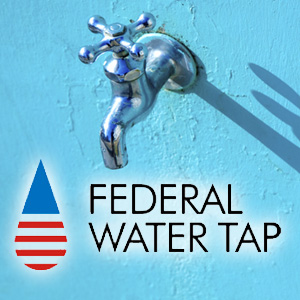Federal Water Tap, October 2: U.S., Mexico Sign Colorado River Agreement
The Rundown
Neighbors once again unite over the Colorado River. Millions in Puerto Rico are still without drinking water or wastewater service. The EPA finds cancer chemical in water near Superfund site flooded by Hurricane Harvey. A House hearing reveals political divisions in water infrastructure funding debate. In moving the Office of Environmental Justice, the EPA fights against the administration’s reputation for environmental neglect. The U.S. Supreme Court’s October term begins today with one water case on the docket. Federal officials visit water hot spots. The National Academy of Sciences begins a study of national water research priorities. The U.S. government’s first global water strategy was due to Congress yesterday. A Senate committee holds a confirmation hearing on October 4 for the head of the EPA Office of Water. And lastly, a study on drinking water affordability ordered by Congress is delayed.
“As we focus on building a new infrastructure package, a new infrastructure approach at the federal level, I believe we need to determine what the federal objectives of this infrastructure package are and develop effective criteria or metrics for us to advance those and complete those objectives as opposed to taking a shot gun approach where we throw a nickel at every ten-dollar problem across the country.” — Rep. Garret Graves (R-LA) speaking at a House Transportation and Infrastructure Committee hearing on September 26 on U.S. water systems.
By the Numbers
210,000 acre-feet: Water allocated to environmental restoration in Mexico as part of a binational Colorado River agreement. (International Boundary and Water Commission)
9: Number of wastewater treatment plants, out of 52 operated by Puerto Rico’s water utility, that are functioning. Twenty-four of the plants are still being assessed. (FEMA)
1.3 million to 2 million: Estimate of the annual number of plastic water bottles that were not purchased at the 23 National Park units that banned the sale of bottled water. The Trump administration recently revoked the policy that allowed parks to ban bottled water sales. (National Park Service)
News Briefs
Colorado River Agreement
After a long negotiation representatives from the United States and Mexico signed an agreement designed to help both sides respond to a diminishing Colorado River. Minute 323, as the agreement is known, is the latest update to a treaty signed in 1944.
The agreement defines cuts in water deliveries that Mexico will take when Lake Mead, the river’s keystone reservoir, drops below certain thresholds. The agreement allows Mexico to store water in the big reservoir. It also establishes a preventative conservation program, in which both countries would reduce water use before Lake Mead gets perilously low. The water conserved is supposed to be made available when Mead rises above 1,110 feet (current level: 1,082 feet), but being able to use all the conservation deferment seems like a convenient fiction given the downward hydrological trend lines in the basin. This provision is contingent on Arizona, California, and Nevada deciding how to split their conservation share.
The United States also committed dollars, pledging $31.5 million for conservation projects in Mexico. Almost half of the conserved water will go to U.S. users. One-third will nourish Mexican wetlands and rivers, and the rest will prop up reservoirs.
Superfund Spill During Hurricane Harvey
The EPA confirmed that Hurricane Harvey damaged a protective cap at a Superfund site along the San Jacinto River, near Houston, and caused a spike in chemical levels in the water.
Water samples from one of 14 monitoring sites at the San Jacinto waste pits indicated levels of dioxin above 70,000 parts per trillion, more than 2,000 times higher than the site’s cleanup goal of 30 parts per trillion. Dioxin is a cancer-causing chemical that stays in the environment for hundreds of years before breaking down.
The risks from flooding were foreseen. In a cleanup plan proposed in 2016, the EPA noted that the protective cap could be damaged by a large hurricane or severe storm that caused the river to rise.
“Sea level rise, storm surge, and heavy downpours in combination with the pattern of continued development in coastal areas are increasing damage to U.S. infrastructure and are also increasing risks to ports and other installations. Because the intensity of future storms and flooding may increase, estimates regarding the ability of a cap (even a cap with increased armoring) to contain the dioxin waste material is highly uncertain,” the report stated.
The pits were built in the 1960s to hold waste material from a paper mill.
EPA Moves Environmental Justice Office
The U.S. Environmental Protection Agency has moved the Office of Environmental Justice from the enforcement office to the policy office.
Discussing the move during an hour-long conference call last week, agency officials asserted that the decision brings environmental justice work closer to the desk of Administrator Scott Pruitt and gives it a higher profile.
Matthew Tejada, head of the Office of Environmental Justice, explained that the EPA made the move because environmental justice cuts across all agency actions.
It was clear from remarks by the three officials on the call that the agency is working against deep skepticism about its dedication to environmental protection and commitment to poor and minority communities exposed to pollution. The officials were adamant that they are committed to the vulnerable.
“It’s a move to elevate environmental justice issues,” said Samantha Dravis, appointed by Pruitt to lead the policy office. “Our commitment to environmental justice is steadfast.” Dravis is guiding the agency’s review of regulations to eliminate.
“The program you have known in the past will be the same program tomorrow,” Tejada added.
Water Infrastructure Hearing
All told, the House Transportation and Infrastructure Committee’s September 26 hearing on U.S. water systems was two hours of reasonable and intelligent discussion of challenges and potential remedies for repairing and investing in U.S. water systems.
But a telling moment occurred near the end of the hearing.
Each of the witnesses, who represented cities, utilities, environmental groups, and businesses, had requested increases in federal spending on water or, in the case of investor-owned utilities, access to federal dollars. Rep. John Garamendi (D-CA) noted an incongruity. Given that House Republican were holding a seminar the following day on reducing federal revenues, how could Congress do that? “How do we get more federal dollars to meet the needs all of you have when we’re actually reducing federal revenues — or, there are many who want to reduce federal revenues?” Garamendi asked.
Rep. Brian Mast (R-FL) responded that dollars are not the right metric: “I think unquestionably one of the biggest things we need to avoid in this institution is the notion that somehow our grade goes up, our grade on the report card goes up, solely based on what we spend. That if we spend one extra dollar we somehow get a better ranking. That can’t be the way this institution functions, especially when we consider it is the fruits of other people’s labor that we deal with here.”
Dollars spent might not be the perfect indicator — there is such a thing as wasteful spending — but it is germane. Inadequate funding is, in fact, a primary reason why America’s water systems are deteriorating. An industry survey three years ago found only one-third of water utilities earned enough revenue to run a sustainable operation. The House hearing showed that the question of where those funds come from — whether it is ratepayers, taxpayers, or an alternative source — remains a hot debate.
Federal Officials Visit Water Hot Spots
Richard Spencer, secretary of the U.S. Navy, visited Bethpage, New York, Newsday reports. Spencer promised residents that the military would pay its share to clean up groundwater contaminated decades ago by volatile organic compounds from an aircraft manufacturing facility that was also shared by Northrop Grumman.
Out West, meanwhile, the Bureau of Reclamation’s second in command will make his third trip to the Klamath River Basin next week, the Herald and News reports. Alan Mikkelsen will meet with landowners in hopes of laying the groundwork for reopening negotiations that derailed two years ago when Congress failed to approve a water-sharing agreement.
Studies and Reports
CRS on Wastewater
Ten bills in Congress have provisions that address wastewater infrastructure, according to a Congressional Research Service report. The report is salted with spending facts: the primary federal loan program for wastewater infrastructure — the Clean Water State Revolving Fund — mainly benefits larger metropolitan areas. Only 22 percent of loan funds since 1989 have gone to communities with a population less than 10,000.
Affordability Report Delayed
A report ordered by Congress on ways to measure the affordability of drinking water and sewer service has been delayed. The report, being prepared by the National Academy of Public Administration, was due by the end of September. It will now be submitted in late October, according to Brenna Isman, the project manager.
National Academy Appraises Water Research
An 11-person National Academy of Sciences panel that is tasked with identifying the highest priority water science research for the next quarter century held its first meeting on September 18.
The panel’s work, which is to conclude in the summer of 2019, will inform the water research mission of the U.S. Geological Survey.
On the Radar
Global Water Strategy Due to Congress
The Trump administration will submit to Congress by October 1 the first plan for incorporating global water security into U.S. government policy. Congress ordered the plan three years ago as part of the Senator Paul Simon Water for the World Act of 2014.
EPA Confirmation Hearing
The Senate Environment and Public Works Committee rescheduled its confirmation hearing for four EPA officials, including the head of the Office of Water, for October 4.
Clean Water Act Case in Supreme Court
There’s one water case on the high court’s docket for the fall session, which begins today. Oral arguments are scheduled for October 11 in National Association of Manufacturers v. Department of Defense. At its heart, the case is about legal territory: which court has the jurisdiction to hear challenges to the EPA’s Clean Water Rule.
Federal lawyers had argued that the case should be delayed because the EPA, under the Trump administration, is now trying to wipe the rule off the books. Some legal observers noted that an indefinite delay would be a means of invalidating the rule without going through the required repeal process.
Glen Canyon Study Group Extended
Interior Secretary Ryan Zinke extended the charter of the Glen Canyon Adaptive Management Work Group, an advisory committee for the operation of the second-tallest dam on the Colorado River.
Federal Water Tap is a weekly digest spotting trends in U.S. government water policy. To get more water news, follow Circle of Blue on Twitter and sign up for our newsletter.
Brett writes about agriculture, energy, infrastructure, and the politics and economics of water in the United States. He also writes the Federal Water Tap, Circle of Blue’s weekly digest of U.S. government water news. He is the winner of two Society of Environmental Journalists reporting awards, one of the top honors in American environmental journalism: first place for explanatory reporting for a series on septic system pollution in the United States(2016) and third place for beat reporting in a small market (2014). He received the Sierra Club’s Distinguished Service Award in 2018. Brett lives in Seattle, where he hikes the mountains and bakes pies. Contact Brett Walton





